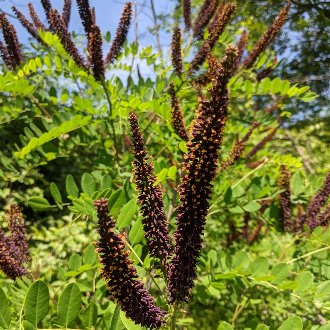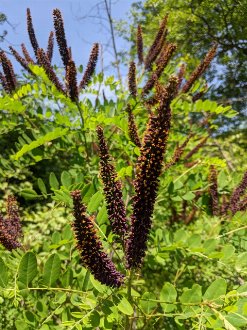False Indigo Bush (Amorpha fruticosa L.)
Also known as desert false indigo.
↑Summary
A shrub native across the southern and central U.S, expanding its range northward.
↑Range - Expand
| Legend | Color |
| Native | |
| Expanded | |
| Native or Not Present | |
| Native or Expanded | |
| Expanded or Not Present | |
| Native or Expanded or Not Present |
This tentative map is based on our own research. It may have limited data on Canada and/or Mexico, and there is some subjectivity in our assignment of plants as introduced vs. expanded. Read more in this blog post.
Although this plant occurs somewhere in each of these regions, it may only occur in a small part of some or all of them.
This species is occasionally planted in landscaping and less commonly in ecological restoration projects. Although it does escape from such use, it is also spreading on its own, taking advantage of humans creating more open and disturbed habitats in bottomlands. It has widely expanded north of its native range, either contiguously with its native range or separated by only short distances.
↑Habitat
Mostly found in wetlands and moist bottomlands, including open forests in floodplains, wet prairies, margins of marshes, and shores of lakes, rivers, and streams. Also found in anthropogenic habitats, such as low, wet areas along roadsides, railroads, and in industrial areas.
Found in wet to moist conditions and tolerant of temporary flooding, but absent from areas with persistent standing water. Found on a variety of soil types and textures, but more common on sites with low nitrogen availability. Can tolerate some shade, but requires significant direct sunlight. It tolerates some salinity and can grow along the more inland portions of tidal estuaries, but is absent from areas closer to the ocean.
Humans have decreased the habitat for this species in much of its range through the destruction of wetlands and conversion of wet prairies to agriculture, but have also created new habitats for it and contributed to it expanding greatly beyond its native range through planting it in landscaping.
↑Uses
Occasionally used in landscaping, where it is valued for relatively small size, tolerance of a wide range of soil and moisture conditions, and its unique deep-purple flowers which often attract butterflies. Its use is sometimes limited by its tendency to form thickets, reproducing aggressively both vegetatively and by seed.
Within and adjacent to its native range, it can also be used for ecological restoration, including erosion control along shorelines, and reclamation of acid mine spoils, especially where these spoils reach into riparian areas and bottomlands that this species favors.
↑Notes
This species is considered invasive in many parts of the world, including primarily Europe and Asia, and also parts of South America. It has the potential to alter succession trajectories, particularly in bottomlands.
In North America, although it has expanded far beyond its native range, the insects that eat it have also expanded with it, and it does not dominate or form large monocultures, and it does not seem to pose any ecological threats in the new areas it has colonized.
↑Links & External Resources
• Amorpha fruticosa (False Indigo) | Illinois Wildflowers (About This Site)
• Amorpha fruticosa (False Indigo Bush) | USDA PLANTS Database (About This Site)
• Amorpha fruticosa | Go Botany (About This Site)
• Amorpha fruticosa (False Indigo) | Missouri Botanical Garden Plant Finder (About This Site)
• Desert False Indigo | Virginia Tech Dendrology Factsheets (About This Site)
• Amorpha fruticosa | Biota of North America Project (BONAP) (About This Site)
• Amorpha fruticosa | NatureServe Explorer (About This Site)
• Amorpha fruticosa | Missouri Plants (About This Site)
• False Indigo Bush | Maryland Biodiversity Project (About This Site)
• Amorpha fruticosa (False Indigo) | Minnesota Wildflowers (About This Site)
• Amorpha fruticosa L. (False Indigo-bush, Tall Indigo-bush) | Digital Atlas of the Virginia Flora (About This Site)




